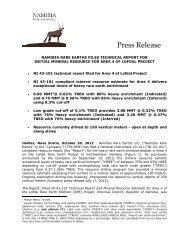Namibia Rare Earths Reports Significant New Drill Results at Lofdal
Namibia Rare Earths Reports Significant New Drill Results at Lofdal
Namibia Rare Earths Reports Significant New Drill Results at Lofdal
You also want an ePaper? Increase the reach of your titles
YUMPU automatically turns print PDFs into web optimized ePapers that Google loves.
2<br />
spaced and deeper holes and confirm the potential of the deposit to continue <strong>at</strong><br />
depth.”<br />
<strong>New</strong> <strong>Drill</strong> <strong>Results</strong><br />
<strong>New</strong> results are highlighted by:<br />
<br />
<br />
<br />
<br />
<br />
<br />
<br />
1.40% TREO over 11.00 meters with 96.1% HREE enrichment<br />
(including 2.08% TREO over 7.00 meters with 97.3% HREE enrichment)<br />
0.56% TREO over 10.00 meters with 73.6% HREE enrichment<br />
(including 1.83% TREO over 2.00 meters with 86.5% HREE enrichment)<br />
0.43% TREO over 20.00 meters with 82.3% HREE enrichment<br />
(including 1.14% TREO over 2.00 meters with 95.2% HREE enrichment)<br />
0.40% TREO over 10.00 meters with 88.0% HREE enrichment<br />
(including 1.81% TREO over 1.00 meter with 97.4% HREE enrichment)<br />
0.31% TREO over 15.00 meters with 71.4% HREE enrichment<br />
(including 1.12% TREO over 1.00 meter with 93.8% HREE enrichment)<br />
0.27% TREO over 30.00 meters with 82.6% HREE enrichment<br />
(including 0.96% TREO over 2.00 meters with 89.6% HREE enrichment)<br />
0.25% TREO over 35.00 meters with 79.1% HREE enrichment<br />
(including 2.49% TREO over 1.00 meter with 95.5% HREE enrichment)<br />
Intercept widths are reported as down the hole widths and are not necessarily true widths.<br />
Interpreted dips of the mineralized zones vary from 45 to 80 degrees and all holes were<br />
drilled <strong>at</strong> -55 degrees. A complete listing of all analytical results is provided in Table 1.<br />
The total meters drilled for the initial Area 4 resource estim<strong>at</strong>e is 9,520 meters of NQ<br />
diamond core with an addition 310 meters of HQ diamond core available for metallurgical<br />
test work. Surface sampling of 13 trenches comprising 870 meters was also completed and<br />
will be incorpor<strong>at</strong>ed into the Area 4 resource model. The resource program remains on<br />
schedule for delivery of the initial NI 43-101 compliant mineral resource report in the third<br />
quarter of 2012.<br />
Resource <strong>Drill</strong>ing Program<br />
The mineral resource drilling program is being carried out on the Area 4 heavy rare earth<br />
enriched 1 target where the 2011 explor<strong>at</strong>ion drilling program had deline<strong>at</strong>ed significant rare<br />
earth mineraliz<strong>at</strong>ion over a 650 meter strike length. The 6,000 meter drilling program has<br />
focused on the first 60-75 vertical meters of the zone with selected step back holes to 100-<br />
150 vertical meters. A single hole was completed targeting the deposit <strong>at</strong> a vertical depth of<br />
250 meters. <strong>Drill</strong>ing services are being provided by JGM <strong>Drill</strong>ing and Explor<strong>at</strong>ion of <strong>Namibia</strong>.<br />
Down-hole geophysical surveys for rock density measurements have been completed on 48<br />
drill holes to d<strong>at</strong>e by Gregory Symons Geophysics of <strong>Namibia</strong>.<br />
These drill results and those previously released from Area 4 (Company press releases<br />
August 3, September 15, December 5, 2011 and March 30, 2012) have demonstr<strong>at</strong>ed th<strong>at</strong><br />
1 As per industry norms heavy rare earths (“HREE”) and their oxide equivalents (“HREO”) comprise europium (Eu),<br />
gadolinium (Gd), terbium (Tb), dysprosium (Dy), holmium (Ho), erbium (Er), thulium (Tm), ytterbium (Yb),<br />
lutetium (Lu) and yttrium (Y). Light rare earths (“LREE”) and their oxide equivalents (“LREO”) comprise<br />
lanthanum (La), cerium (Ce), praseodymium (Pr), neodymium (Nd) and samarium (Sm). Total rare earths<br />
(“TREE”) and their oxide equivalent (“TREO”) comprise HREE+LREE (HREO+LREO). “Heavy rare earth enrichment”<br />
is the r<strong>at</strong>io of HREE:TREE or HREO:TREO expressed as a percentage. R<strong>at</strong>ios are calcul<strong>at</strong>ed from source d<strong>at</strong>a and<br />
may vary from use of rounded numbers in tables.




